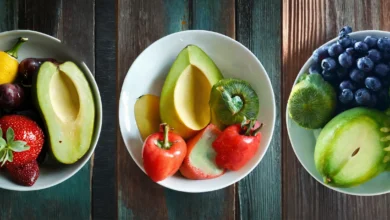What are the best ways to lose weight at home?

What are the best ways to lose weight at home?
Losing weight from the comfort of your home can be a convenient and effective way to achieve your fitness goals. With the right strategies, such as establishing a nutritious diet, creating a consistent exercise routine, leveraging technology, making behavioral changes, and understanding how to overcome plateaus, you can embark on a weight loss journey that fits your lifestyle. This article explores the best practices for shedding pounds at home, offering practical advice and actionable steps to help you succeed.
Key Takeaways
- A balanced diet rich in whole foods and an understanding of macronutrients are crucial for effective weight loss at home.
- Home-based workouts, including bodyweight exercises, cardio, and yoga, can be tailored to fit any fitness level and schedule.
- Technology, such as fitness apps, virtual classes, and wearable trackers, can enhance your weight loss efforts by providing guidance and tracking progress.
- Long-term weight loss success is often tied to behavioral changes like setting realistic goals, developing healthy habits, and practicing mindful eating.
- Recognizing and overcoming weight loss plateaus is essential, and may involve adjusting your diet and exercise plan, focusing on sleep and recovery, or seeking professional advice.
Establishing a Nutritious Diet
Understanding Macronutrients and Calories
To effectively lose weight at home, it’s crucial to understand the role of macronutrients—proteins, fats, and carbohydrates—in your diet. Calories are the energy units from food that fuel our body, and managing caloric intake is essential for weight loss. Each macronutrient has a specific calorie count per gram:
| Macronutrient | Calories per gram |
| Protein | 4 |
| Carbohydrates | 4 |
| Fats | 9 |
Proteins are vital for muscle repair and growth, fats are important for hormone production and nutrient absorption, and carbohydrates are the body’s main energy source. Balancing these macronutrients can help you create a diet that supports weight loss while also providing the nutrients your body needs.
By focusing on the quality and quantity of these macronutrients, you can design a diet that not only helps you shed pounds but also boosts your overall health.
Remember, it’s not just about cutting calories but consuming the right kind of calories. Incorporating a variety of nutrient-dense foods will ensure you get the necessary vitamins and minerals without overeating.
Incorporating Whole Foods
Incorporating whole foods into your diet is a cornerstone of weight loss at home. Whole foods are unprocessed and unrefined, or processed and refined as little as possible before being consumed. They are free of additives or other artificial substances, making them a healthier option compared to processed foods.
Eating a variety of whole foods provides your body with essential nutrients that can help boost metabolism and reduce cravings. Here’s a simple guide to get started:
- Fruits and Vegetables: Rich in fiber, vitamins, and minerals.
- Whole Grains: Such as brown rice, quinoa, and whole wheat, which offer sustained energy.
- Proteins: Lean meats, legumes, and nuts for muscle repair and growth.
- Healthy Fats: Avocado, olive oil, and seeds to keep you full and satisfied.
By focusing on whole foods, you not only nourish your body but also create a natural calorie deficit by replacing high-calorie processed foods with nutrient-dense alternatives.
Remember, the key to successful weight loss is not just about what you eat, but also how much and how often. Portion control and regular meal times play a significant role in managing your weight effectively.
Meal Planning and Preparation
Effective meal planning and preparation are crucial for weight loss success at home. By organizing your meals in advance, you can ensure that you’re consuming the right balance of nutrients while also managing portion sizes. Start by creating a weekly meal plan that includes a variety of nutrient-dense foods, and prepare as much as you can ahead of time to make healthy eating convenient.
- Determine your calorie and macronutrient needs
- Choose recipes that align with your weight loss goals
- Prepare a grocery list to avoid impulse purchases
- Set aside time for meal prep to streamline your week
Consistency in meal planning and preparation can significantly reduce the temptation to indulge in unhealthy foods. It also saves time and reduces food waste, making it an environmentally and budget-friendly practice.
Remember, the key to effective meal planning is to keep it simple and sustainable. Incorporate foods you enjoy and are likely to eat regularly. This approach not only supports weight loss but also helps in maintaining a healthy lifestyle in the long term.
Hydration and Its Role in Weight Loss
Staying well-hydrated is essential for maintaining a healthy metabolism and facilitating weight loss. Water is a key component in metabolizing stored fat and helps to ensure that your body functions optimally. Additionally, drinking water can aid in appetite control, as it often reduces the sensation of hunger.
- Drink a glass of water before meals to help feel fuller.
- Replace sugary drinks with water to reduce calorie intake.
- Keep a water bottle handy throughout the day to stay hydrated.
Proper hydration can also improve your workouts by increasing stamina and reducing the risk of fatigue. It’s important to listen to your body and drink water consistently, not just when you feel thirsty. Adequate water intake is a simple yet effective tool in your weight loss arsenal.
Creating an Effective Exercise Routine
Bodyweight Workouts for Strength and Toning
Bodyweight exercises are a fantastic way to build strength and tone muscles without the need for any equipment. These workouts can be done anywhere, making them ideal for home fitness routines. They rely on your own body weight to provide resistance against gravity, challenging your muscles through various movements.
- Push-ups
- Squats
- Lunges
- Planks
- Burpees
Each exercise targets different muscle groups, and when combined, they offer a comprehensive workout that can improve overall body strength and muscle definition. It’s important to focus on form to maximize the benefits and reduce the risk of injury.
Consistency is key in any workout regimen. Aim to incorporate bodyweight exercises into your routine several times a week, gradually increasing the intensity and variety of movements to continue challenging your body and preventing plateaus.
Cardiovascular Exercises for Fat Loss
Cardiovascular exercises, often referred to as cardio, are essential for burning calories and improving heart health. Engaging in regular cardio workouts can significantly enhance fat loss efforts at home.
- High-Intensity Interval Training (HIIT): Alternating short bursts of intense activity with periods of rest.
- Running or Jogging: A straightforward way to start; no equipment needed.
- Jumping Rope: An effective calorie-burner that improves coordination.
- Cycling: Stationary or outdoor biking can be a low-impact option.
Consistency in cardiovascular exercises is key to seeing results. Aim for at least 150 minutes of moderate-intensity or 75 minutes of high-intensity cardio per week, as recommended by health authorities.
Remember, the best cardio workout is one that you enjoy and can stick with over time. Start with activities that you find fun and gradually increase the intensity and duration as your fitness level improves.
Yoga and Flexibility Training
Incorporating yoga and flexibility training into your home workout routine can be a transformative experience, not just for weight loss but for overall well-being. Yoga enhances flexibility, strength, and balance, which can complement your weight loss efforts by improving your body’s ability to perform other exercises more effectively.
- Start with basic poses to warm up your body
- Gradually move to more challenging poses
- Include a mix of stretching and strength-building asanas
- Finish with a relaxation pose to help your body recover
Consistent practice is key to reaping the full benefits of yoga. It’s not just about the physical postures; the mindful breathing and meditation aspects can also help reduce stress, which is often linked to weight gain.
Remember, flexibility training is not a race. It’s important to listen to your body and progress at your own pace. Over time, you’ll likely notice improvements in your posture, core strength, and overall muscle tone, all of which contribute to a healthier weight and body composition.
Consistency and Progress Tracking
Maintaining a consistent exercise routine is crucial for weight loss success at home. Tracking your progress is not only motivating but also provides valuable feedback on your journey. Regularly recording your workouts, along with any changes in weight or body measurements, can help you understand what is working and what might need adjustment.
- Workout Frequency: Aim for at least 3-4 times a week.
- Intensity Levels: Note if you’re increasing the intensity over time.
- Duration: Keep track of how long your workouts last.
- Type of Exercise: Record the kinds of exercises you’re doing.
Consistency in your workouts leads to improvements in fitness and weight loss. It’s the small, daily efforts that compound over time to yield significant results. Remember, the goal is to make exercise a regular part of your lifestyle.
Adjusting your routine based on the feedback from your tracking can help you overcome plateaus and continue making progress. Whether it’s increasing the intensity of your workouts or incorporating new exercises, staying adaptable is key.
Leveraging Technology for Weight Loss
Fitness Apps and Online Resources
In the digital age, leveraging technology can be a game-changer for those looking to lose weight at home. Fitness apps and online resources provide a wealth of information and tools that can help you track your progress, stay motivated, and adhere to your weight loss goals. From calorie counters to virtual workout classes, the options are virtually limitless.
- Calorie Tracking Apps: Log your daily food intake to stay on top of your calorie goals.
- Workout Apps: Access a variety of exercise programs and tailor them to your fitness level.
- Nutrition Guides: Find healthy recipes and nutrition tips to support your diet.
- Community Support: Connect with others on a similar weight loss journey for encouragement.
Embracing these technological aids can simplify the process of losing weight by providing structured plans and real-time feedback. It’s important to find the right combination of apps and online resources that resonate with your personal preferences and lifestyle.
Virtual Training and Classes
With the rise of digital technology, virtual training and classes have become a popular and convenient way to lose weight at home. These online platforms offer a variety of workout programs that cater to different fitness levels and preferences.
- Live Classes: Engage in real-time with instructors for motivation.
- On-Demand Workouts: Access pre-recorded sessions at your convenience.
- Diverse Genres: From high-intensity interval training (HIIT) to dance, find a style that you enjoy.
- Community Support: Many platforms have built-in communities for encouragement and support.
Embracing virtual training allows for a flexible schedule, making it easier to commit to regular exercise. It eliminates the need for commuting to a gym and provides a safe space for those who are self-conscious about working out in public.
Moreover, virtual classes can be a cost-effective solution. While some services require a subscription, others may offer free content or one-time purchase options. It’s important to research and choose a platform that aligns with your goals and budget.
Wearable Fitness Trackers
Wearable fitness trackers have revolutionized the way we approach weight loss at home. These devices provide real-time data on our physical activities, making it easier to monitor progress and stay motivated. They can track steps taken, calories burned, heart rate, and even sleep patterns, offering a comprehensive overview of our health and fitness levels.
- Track daily activity levels
- Monitor heart rate and sleep quality
- Set and achieve fitness goals
- Sync with smartphones or computers for detailed analysis
Wearable trackers encourage accountability and can be a fun way to challenge yourself to move more throughout the day. By setting daily or weekly goals, you can gradually increase your activity level in a manageable way.
Understanding the data from your fitness tracker can help you make informed decisions about your exercise routine and dietary choices. For instance, noticing that your heart rate doesn’t elevate as much during your usual workout may indicate it’s time to increase the intensity or try new exercises to continue progressing.
Social Media for Motivation and Accountability
Harnessing the power of social media can significantly enhance your weight loss journey at home. Platforms like Instagram, Facebook, and Twitter can serve as sources of inspiration and peer support. They allow you to follow fitness influencers, join weight loss communities, and share your progress, which can keep you accountable and motivated.
- Follow fitness influencers for daily motivation and tips.
- Join groups or communities focused on weight loss and healthy living.
- Share your milestones to celebrate progress and receive encouragement.
By making your goals public, you’re more likely to stay committed to your weight loss plan. Social media creates a sense of community, making the process less isolating and more supportive.
Remember to maintain a balance and not let social media dictate your self-worth or progress. Use it as a tool to stay on track, but ensure that your journey remains personal and true to your own goals and needs.
Behavioral Changes for Sustainable Weight Loss
Setting Realistic Goals
When embarking on a weight loss journey at home, setting realistic goals is crucial for maintaining motivation and ensuring progress. Unrealistic expectations can lead to disappointment and a higher likelihood of abandoning your efforts.
- Start by determining a healthy target weight range based on your body composition rather than a specific number.
- Break down your main goal into smaller, achievable milestones.
- Celebrate each success to keep your spirits high and stay committed.
Remember, weight loss is a marathon, not a sprint. Patience and perseverance will serve you better than haste and impractical ambitions.
Consistently revisiting and adjusting your goals can help you stay on track. It’s important to be flexible and kind to yourself as your body adapts to new routines and dietary changes.
Developing Healthy Habits
Developing healthy habits is crucial for long-term weight loss success. Consistency is key; by establishing routines, you can make healthy choices more automatic and less reliant on willpower. Start with small, manageable changes that you can stick to over time.
- Prioritize sleep: Aim for 7-9 hours per night.
- Manage stress: Practice relaxation techniques daily.
- Stay active: Incorporate movement into your day, beyond exercise sessions.
- Eat mindfully: Pay attention to hunger and fullness cues.
Remember, it’s not about perfection, but about making better choices more often. Building these habits can create a foundation for a healthier lifestyle that supports weight loss.
Track your habits to monitor progress and make adjustments as needed. Celebrate small victories to stay motivated, and don’t be too hard on yourself when you face setbacks. Over time, these habits can become second nature, making it easier to maintain a healthy weight.
Mindful Eating Techniques
Mindful eating is about being fully present and engaged with the eating experience. It involves paying attention to the flavors, textures, and sensations of your food, as well as your body’s hunger and fullness cues. Practicing mindful eating can help prevent overeating and make meals more satisfying.
- Start by eating without distractions, such as TV or smartphones.
- Chew your food thoroughly and savor each bite.
- Listen to your body and stop eating when you’re comfortably full.
- Reflect on your emotional state before meals to identify if you’re truly hungry or just bored or stressed.
By slowing down and appreciating your meals, you create a more connected and enjoyable eating experience that can support your weight loss goals.
Mindful eating isn’t about strict rules or diets; it’s a shift in how you approach food. It’s a skill that gets better with practice and can lead to a healthier relationship with food.
Coping with Stress and Emotional Eating
Stress and emotional eating can sabotage your weight loss efforts by leading to unhealthy snacking and overeating. Identifying your emotional eating triggers is the first step towards managing this behavior. Once you know what prompts your emotional eating, you can begin to develop strategies to cope more healthfully.
- Recognize the signs of emotional hunger vs. physical hunger.
- Find alternative activities to eating that can help you cope with stress, such as meditation, walking, or journaling.
- Establish a support system of friends or family who understand your goals and can offer encouragement.
Remember, it’s not about perfection but progress. Be kind to yourself and acknowledge that managing stress is a skill that takes time to develop.
If you find yourself repeatedly turning to food for comfort, consider seeking professional help. A therapist or counselor can provide you with tools to manage your emotions in a healthier way. This step is crucial, as emotional well-being is just as important as physical health in your weight loss journey.
Understanding and Overcoming Plateaus
Identifying Causes of Weight Loss Plateaus
Weight loss plateaus can be a frustrating part of the journey towards a healthier body. Understanding the reasons behind these standstills is crucial for overcoming them and continuing progress. Several factors contribute to weight loss plateaus, including:
- Metabolic adaptations as the body becomes more efficient with energy use.
- Decreased physical activity or overestimation of caloric expenditure.
- Inadequate dietary adjustments as weight decreases.
- Plateauing due to a lack of variety in exercise routines.
It’s important to remember that plateaus are a natural and expected part of weight loss. They signal the need for changes in your approach.
By identifying the specific cause of a weight loss plateau, you can make the necessary adjustments to your diet and exercise plan to resume progress. Consistently reassessing and tweaking your strategies is key to long-term success.
Adjusting Your Diet and Exercise Plan
When you hit a plateau, it’s crucial to reassess and adjust your diet and exercise plan to continue making progress. Tweaking your caloric intake and macronutrient ratios can jumpstart your metabolism. For instance, slightly reducing your daily calories or increasing your protein intake can make a significant difference.
- Review your current caloric intake
- Adjust macronutrient ratios (more protein, fewer carbs)
- Incorporate new exercises to challenge your body
Remember, the key is to make small, sustainable changes rather than drastic overhauls that are hard to maintain.
It’s also essential to vary your workout routine to prevent adaptation. Introducing new exercises or increasing the intensity can help overcome a weight loss plateau. Keep a log of your adjustments to monitor what works best for you.
The Importance of Sleep and Recovery
Adequate sleep and recovery are crucial components of a successful weight loss journey. Sleep is essential for regulating metabolism and appetite, influencing both your ability to lose weight and maintain a healthy weight long-term. Lack of sleep can lead to increased hunger and cravings, making it harder to stick to your diet plan.
During sleep, the body undergoes repair and recovery processes that are vital for muscle growth and recovery after exercise. This restorative period allows your muscles to heal from the microtears caused by physical activity, which in turn helps to build strength and improve body composition.
To optimize your weight loss efforts, aim for 7-9 hours of quality sleep each night. Establish a consistent sleep schedule by going to bed and waking up at the same times every day, even on weekends. Consider the following tips to enhance your sleep quality:
- Create a restful sleeping environment by minimizing noise and light.
- Avoid caffeine and heavy meals close to bedtime.
- Engage in relaxing activities before bed, such as reading or taking a warm bath.
Remember, sleep and recovery are not just about quantity but also quality. By prioritizing both, you’ll support your body’s natural weight loss processes and improve your overall health.
When to Seek Professional Advice
Reaching a weight loss plateau can be frustrating, and sometimes, despite your best efforts, you might find yourself unable to progress. When your strategies no longer yield results, it’s time to seek professional advice. Professionals can provide personalized guidance tailored to your unique body and lifestyle.
- Consult a dietitian for a customized meal plan.
- See a personal trainer to refine your exercise routine.
- Visit a doctor to rule out any underlying medical conditions.
- Talk to a psychologist if you suspect emotional eating patterns.
Remember, asking for help is not a sign of failure but a step towards a more effective and sustainable weight loss journey. Professionals can offer new perspectives and strategies that you might not have considered, helping you overcome obstacles and continue towards your goals.
Conclusion
In conclusion, losing weight at home is entirely achievable with the right approach and mindset. By incorporating a balanced diet, regular physical activity, and mindful lifestyle changes, individuals can create a sustainable weight loss journey. It’s important to remember that consistency is key, and setting realistic goals can help maintain motivation. Additionally, leveraging the convenience of home workouts and the control over dietary choices can make the process more manageable. Always consult with a healthcare professional before starting any new diet or exercise program to ensure it’s safe and appropriate for your individual health needs. With dedication and patience, you can reach your weight loss goals from the comfort of your home.




